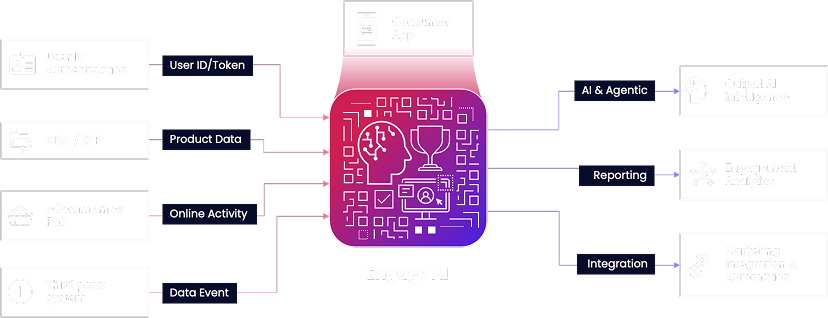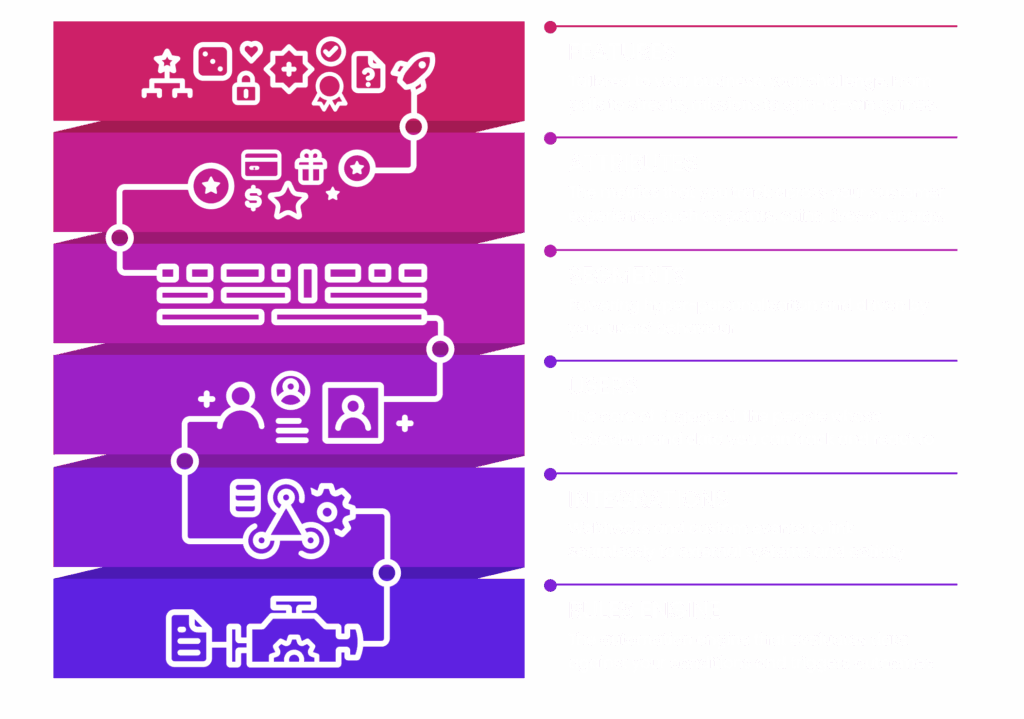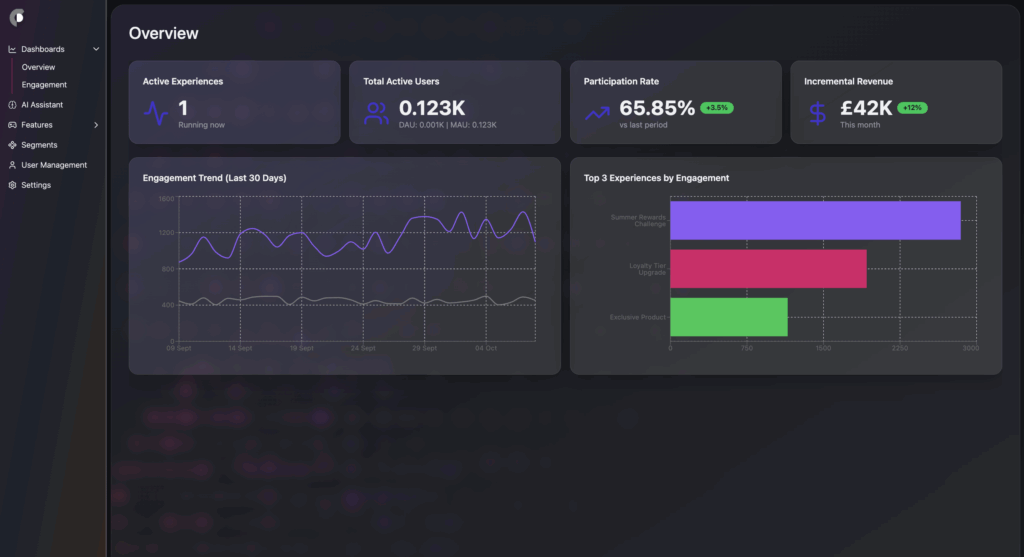About Engage AI
The Platform
Engage AI is a headless engagement platform, deployed into your own Azure environment, that gives organisations the power to create, deliver and scale interactive experiences for their users.
At the heart of the platform are Experiences, made up of a bundle of features tailored to your challenge. These experiences are the journeys that shape how a customer interacts with your brand. An experience might comprise of a mission to complete, a challenge to take part in and a journey of progression that plays out over time to tackle the challenge of app engagement. This is just one example.

Experiences aren’t pre-set templates. They are composed from a combination of features, mechanics, rules and rewards, which you tailor to fit your business goals. For example, a mission might bring together an objective (“log in three times this week”), a rule to detect completion and a reward such as experience points, bonus data or a badge. A season pass might link together multiple missions, streaks to reward consistency, leaderboards to create social competition and tiered rewards to keep users progressing.
Because Engage AI is headless, these experiences are designed and orchestrated in the platform but surfaced wherever you need them, inside your mobile app, e-commerce portal, streaming service or any other digital channel. The engagement logic and data run invisibly in the background, while your front end retains full control of the brand experience. Developers would use APIs to surface missions, quizzes or leaderboards natively in your interfaces, while product owners and marketers configure the mechanics, rules and content through the Engage AI console.
The architecture is layered for clarity.
At it’s core is a rules engine which automates response data in real time against your conditions. On top of this are the integrations connect Engage AI seamlessly with the rest of your ecosystem. Your users and segments sit above this, with the segments layer responding to the rules engine output in real time, and aim Experiences at users in a way that is relevant to the individual. At the top sits the attributes and features, the part that brings it to life. These are the outputs from everything below and are your points of engagement with your users. The features layer is a breakdown of your Experience and allows you to design and orchestrate interactions ranging from simple polls to complex progression systems, while the attributes track the numbers that matter. Running throughout all of this is an AI scaffold. Every action a user takes is captured and fed into this, providing insight into what is working and where to optimise. An AI Assistant allows teams to query the system in natural language, while AI-driven content tools can generate quizzes, missions or campaigns in minutes.

What makes Engage AI stand out is not just the technology but the blend of automation and expertise. Data and AI provide the precision, rules and APIs provide the structure and behavioural science guides the design of experiences so they feel human, meaningful and motivating. This orchestration ensures that experiences are not generic, but adaptive to each individual user, aligning directly with your business objectives.
The Layers of Engage AI
Below explains each core component in detail, what it is, why it matters and how to use it. You’ll find conceptual overviews to help you design better engagement strategies, API references and examples so your teams can build and integrate with confidence, and a link to a full description of each core feature that we provide.
Rules Engine
The Rules Engine is what ties the whole experience together. It listens to everything that moves through Engage AI, evaluates it against your conditions and triggers the right outcomes without manual intervention. When a user completes a mission, hits a new level or changes an attribute, the engine decides what should happen next. That might be awarding a reward, adding the user to a new segment, removing them from an old one or pushing an update into your CRM. Because it works in real time, the experience feels immediate and consistent for the user and your teams don’t end up running scripts or spreadsheets to catch up.
Think of it as your automation layer. You define the events to watch, the conditions that must be true and the actions to fire. A simple example is the “Gain 1,000 points” mission. As soon as a user’s points increase and the mission’s objective is met, the engine confirms completion, unlocks the reward, moves the user into the “frequent_shopper” segment and posts a CRM update so they receive a tailored message. Nothing is queued for later and there is no manual approval loop unless you choose to add one.
The real value for marketing is reliability. Campaigns behave exactly as designed and every user is treated fairly and promptly. For product owners, the Rules Engine provides a scalable control plane for progression logic, segmentation and integrations. You can start with simple if-this-then-that flows and grow into more elaborate chains that branch by segment, geography or time window. Because the engine sits behind the APIs, your front end always reads a source of truth that has already applied your rules.
Integrations
Webhooks
Webhooks are how Engage AI communicates events to your external systems in real time. Whenever something important happens in the platform, such as a mission being completed, an attribute reaching a threshold or a reward being unlocked, a webhook can be triggered to send that information to an endpoint you control. This means you don’t have to poll the APIs; instead, your systems are notified automatically.
Webhooks make integrations seamless. They let you trigger downstream actions like sending an email, updating a CRM record, pushing a mobile notification, or adjusting a marketing automation workflow. Because they operate instantly, users feel the impact of their actions without delay, which makes the experience smoother and more engaging.
For marketing teams, webhooks ensure consistency across tools. A reward unlocked in Engage AI can immediately appear in your CRM or loyalty platform, making it easy to run cross-channel campaigns. For product owners, webhooks are the backbone of system integrations, scalable, flexible and easy to configure for different event types.
Custom Events
Custom events are how you bring external activity into Engage AI so that it can be processed by the Rules Engine and tied into your gamification flows. They act as signals from your systems, apps or platforms, telling Engage AI when something important has happened. From there, the Rules Engine can evaluate the event and trigger the right outcomes, such as awarding an attribute, completing a mission, unlocking a reward or updating a segment.
Think of custom events as the opposite of webhooks. Webhooks send data out from Engage AI to your systems when something changes. Custom events bring data in to Engage AI from your systems so those changes can be acted on. Together, they create a two-way integration: your external tools tell Engage AI what’s happening and Engage AI tells your tools what it’s doing in response.
A custom event can represent almost anything. For example, you might fire an event when a user makes a purchase, completes a video tutorial or attends an event. These events don’t need to map directly to Engage AI’s built-in objects (like missions or attributes), they are flexible signals that you define. Once they are in the system, you can attach rules to them, just like you would with native events.
For marketing teams, custom events make it possible to align gamification with the behaviours that matter most in your business. Instead of only tracking in-app actions, you can reward real-world activities like attending a live event or sharing a product on social media. For product owners, custom events give you the freedom to integrate Engage AI with your broader ecosystem without needing to warp your data into a rigid model.
Practical Example
Imagine you want to reward users for attending webinars. You define a custom event called webinar_attended with fields for userId, webinarId and timestamp. Each time someone attends, your system calls Engage AI with that event. The Rules Engine receives it, checks if any conditions are met (for example, attending three webinars in a month) and then triggers the outcomes you’ve defined, such as awarding points, unlocking a badg or moving the user into a “Highly Engaged” segment.
In this way, custom events let you stitch your real-world and digital engagement together into a single gamified journey.
Users
Users are the core of Engage AI. They are the people whose behaviour, data and engagement you track, reward and personalise Experiences for. Everything in Engage AI, from attributes to levels, missions to leaderboards, relates back to users, so having a solid understanding of what data is held, how users are referenced and how to work with them via API is critical.
When someone signs up, or is created via your system, a user record is created in Engage AI. That record holds all identity-level data (IDs, possibly name/email or other identifiers), the attributes associated with that person, which segments they belong to, what missions they’ve completed, what levels or tiers they’re at and their quiz history. Because user data is the single source of truth for personalisation and gamification, everything else (missions, rules, etc.) feeds into or reads from these user records.
For product owners, the Users API lets you fetch user data programmatically. You can look up a user by their ID, get their current attributes and levels, see which segments they’re part of, find out what missions or quizzes they’ve completed and more. This is useful when building UI dashboards, automations in external systems or integrating with CRMs.
Marketing teams benefit from the users feature by using this data to understand behaviour: who are your power users, which users are slipping, who are close to hitting the next level or tier, who are frequently participating in quizzes, etc. You can use that insight to trigger email campaigns, rewards or personalised messaging to encourage further engagement.
Segments
Segments are what power hyper-personalisation in Engage AI. They let you group users dynamically based on their behaviours, attributes or progression, so you can deliver the right experiences to the right people at the right time. Instead of running one-size-fits-all campaigns, segments allow you to create targeted engagement that is relevant dynamic and hyper-personal.
A segment can be defined by any combination of rules. For example, you might create a “Frequent Shoppers” segment made up of users with more than 5,000 loyalty points, or a “New Fans” segment for people who signed up in the last 30 days. Segments update in real time as users’ data changes. If a user crosses the threshold, they are automatically added to the segment; if they fall out of scope, they are removed.
Segments can be used across the whole Engage AI platform. Missions can be restricted to specific segments so that only qualifying users see them. Rewards can be configured to unlock only for certain segments, ensuring exclusivity. Leaderboards can be tailored so that users compete only with others in their segment, such as local fans within a city. Even external integrations like CRM updates can reference segment membership, so that your marketing automation tools always know exactly who belongs where.
For marketing teams, segments are the key to relevance. They make it possible to send targeted offers, highlight the right rewards, and celebrate milestones for the audiences who will appreciate them most. For product owners, segments provide the framework for scaling personalisation. By creating the right rules, you ensure that every part of your engagement strategy adapts automatically as users progress.
Attributes
Attributes are the foundation of Engage AI’s gamification system. They are the metrics that you track across your experience, such as points, coins, lives or energy. Every attribute represents a value that belongs to a user and those values can grow, reset or be capped depending on the rules you set. Attributes are flexible and they can be used to drive a wide range of experiences, from loyalty points in retail programmes, to in-app currencies in games or even virtual tokens that unlock special rewards.
The API allows attributes to be created, updated and retrieved programmatically. A typical request to get an attribute by ID will return the identifier, the human-readable name, its description and any conditions that apply, such as minimum or maximum values. This makes it easy to integrate attributes into your app logic, ensuring that they update in real time whenever users take actions.
In practice, attributes give you the building blocks for your gamified experience. A telecom provider might introduce “data coins” that customers earn with every top-up, which can later be spent on prizes or bonus data. A retailer might assign loyalty points for purchases and referrals. A sports broadcaster could track “fan XP” to recognise those who tune in regularly, participate in predictions and engage on social media. Whatever the context, attributes allow you to measure behaviour in a way that can be turned into rewards, progression and recognition.
By designing your attributes carefully, you set the stage for deeper engagement. They give structure to the experience, they make progress visible and they create opportunities for your audience to feel a sense of achievement.
Features
Engage AI comes with a powerful set of features designed to drive engagement, loyalty and long-term value. Missions guide users through challenges with clear goals and rewards, while Streaks build lasting habits through consistency. Leaderboards introduce competition and community, and Levels and Tiers give progression and status real meaning. Quizzes bring fun, interactive moments and Consumables add urgency with one-off boosts, vouchers or perks. Each feature can stand alone, but when layered together they create rich, personalised experiences that keep users motivated, connected and coming back.
Reporting & Insights
Every interaction within Engage AI generates valuable first-party data from missions completed and streaks maintained to attributes earned and rewards redeemed. Turning that activity into meaningful insight is critical for both marketing and product teams. Engage AI provides two complementary layers of reporting designed to deliver both granular experience-level feedback and enterprise-wide intelligence.
Experience Led Reporting
Experience-led reporting focuses on the performance of a specific experience such as a group of missions, campaign or seasonal challenge and how users are engaging with it in real time. For each experience, OBT Live’s engagement architects design custom dashboards that visualise participation, completion rates, reward redemptions and behavioural patterns. These dashboards provide a clear view of what is working, where users drop off and how changes to rules or rewards affect outcomes.

Experience-led dashboards are built for action. They allow marketing and product teams to optimise while a campaign is live. You can compare user cohorts, test variations of missions or streaks and see the direct impact of adjustments on engagement levels.
Data Led Reporting
Beyond individual experiences, Engage AI captures a complete, unified dataset of all engagement activity. This data can be streamed directly into your organisation’s analytics environment typically Microsoft Fabric within your Azure tenancy where it can be combined with existing business data such as sales, CRM or media performance.

Data-led reporting provides the enterprise-wide picture. It lets you correlate engagement with revenue, retention or other business KPIs and build advanced analytics or predictive models using Fabric’s AI and data tools. Fabric dashboards are for identifying which mechanics drive the highest lifetime value, which segments are most responsive and where to focus future investment.
By offering both experience-led and data-led reporting, Engage AI ensures that insights are available at every level from the front-line campaign team optimising a mission in real time, to the executive measuring ROI across markets and channels. Whether you need to understand a single experience or the full engagement ecosystem, the data is structured, accessible and ready to drive smarter decisions.
Deeper Dive
For a deeper dive into our technical documentation head to our Engage AI docs site, which contains a step by step user guide on using the platform alongside API references.